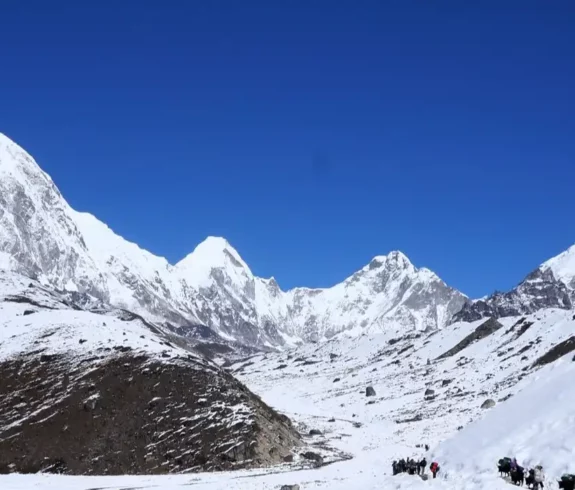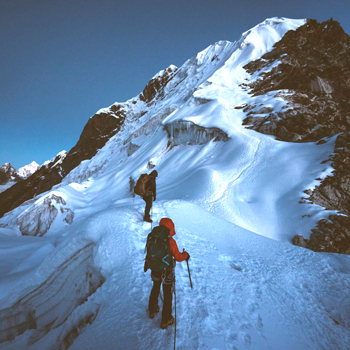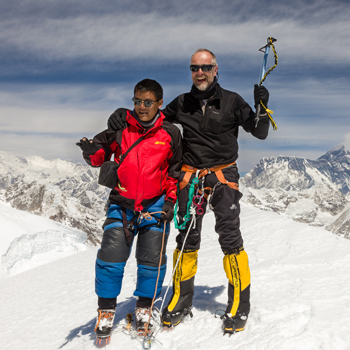Understanding the Lobuche Peak Climbing Difficulty is essential for anyone considering this challenging ascent in the Himalayas. The Khumbu region of Nepal is home to Lobuche Peak, which stands near the famous Mount Everest. This peak features two main summits: Lobuche East at 6,119 meters and Lobuche West at 6,145 meters.
Despite Lobuche West being slightly higher, only Lobuche East is open to climbers as a permitted trekking peak. The Nepal Mountaineering Association designates Lobuche East for climbing, making it accessible without needing an expensive expedition permit.
Situated close to the Everest Base Camp, Lobuche East Peak offers breathtaking panoramic views of the Himalayas, including towering mountains like Ama Dablam, Nuptse, and Lhotse. Its strategic location provides climbers with a unique vantage point to appreciate the grandeur of the Himalayas. The peak’s prominence in the Khumbu Valley underscores its significance for those seeking to experience high-altitude mountaineering in Nepal.
The Lobuche Peak Climb tests physical endurance and technical skills, setting it apart from other trekking peaks in the region. Climbers must navigate steep slopes and icy terrains, which adds to the allure and challenge of this expedition.
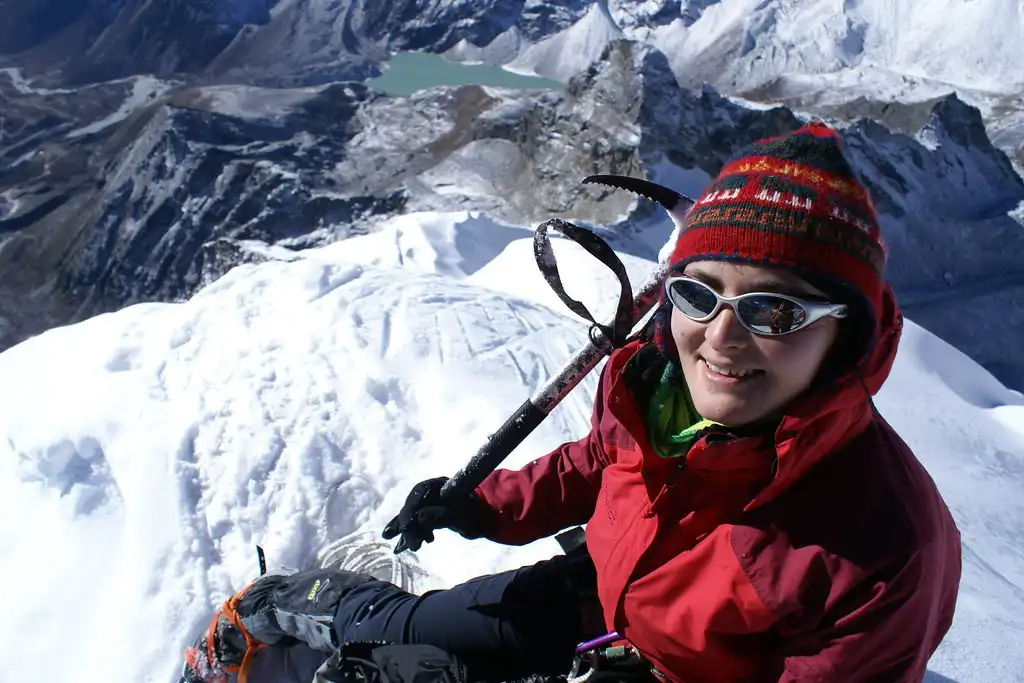
Popularity Among Climbers
Lobuche Peak has become a sought-after destination for both novice and seasoned climbers. Its challenging routes, technical sections, and overall Lobuche Peak Climbing Difficulty attract those eager to test their abilities in the Himalayas. Compared to peaks like Island Peak or Mera Peak, the climbing difficulty is notably higher due to its steeper ascents and more demanding terrain. Several factors contribute to its growing popularity:
- Technical Challenge: The climb requires proficiency with crampons, ice axes, and ropes, offering an actual test of mountaineering skills.
- Preparation for Higher Peaks: Many use the Lobuche Peak Expedition to prepare for scaling higher mountains, such as Mount Everest.
- Cultural Experience: Climbers can explore the rich culture of the Khumbu region and interact with the Sherpa community.
Understanding the Climbing Difficulty
The Lobuche Peak climbing difficulty is renowned for its demanding technical challenges. Climbers face steep snow and ice slopes that require advanced mountaineering skills. The ascent involves navigating knife-edge ridges, which test balance and nerve due to their narrow and exposed nature.
Using fixed ropes is essential on Lobuche Peak. Climbers must be proficient in ascending and descending these ropes, especially on steep and icy sections. The terrain includes glacier crossings with hidden crevasses, adding another layer of complexity. Proper use of equipment like crampons and ice axes is crucial for safety. Key technical aspects to consider:
- Steep Snow and Ice Slopes: Slopes can exceed 50 degrees, necessitating front-pointing techniques.
- Knife-Edge Ridges: These sections demand careful footwork and steady composure.
- Fixed Ropes Usage: Mastery of jumars and belaying techniques enhances safety.
- Glacier Navigation: Awareness of crevasse zones and rope team travel is essential.
- Altitude Impact: High elevation affects physical performance and requires acclimatization.
Comparison with Other Peaks
Its technical nature becomes evident when comparing the “Lobuche Peak climbing difficulty” with other trekking peaks in Nepal. For instance, Island Peak (Imja Tse) is famous among climbers but is considered less technical. Island Peak involves glacier travel and a headwall near the summit but needs more knife-edge ridges found on Lobuche Peak.
Mera Peak is another trekking peak favored for its altitude but is technically straightforward. The ascent primarily involves trekking on snow-covered slopes with minimal technical sections, making it suitable for climbers with basic skills. Key comparisons:
- Technical Difficulty: Lobuche Peak requires advanced climbing techniques, whereas Island Peak and Mera Peak are accessible to those with fundamental mountaineering experience.
- Terrain Complexity: The knife-edge ridges and steep slopes on Lobuche Peak present more complex challenges than the gradual ascents on Mera Peak.
- Skill Requirement: Proficiency in using fixed ropes and ice climbing is more critical on Lobuche Peak.
- Preparation: Due to its challenging nature, climbers often use Lobuche East Peak to prepare for higher technical climbs.
Climbing Routes and Key Sections
Common Routes
Understanding the Lobuche Peak Climbing Difficulty starts with knowing the common routes to the summit. The standard route to Lobuche East Peak is via the south ridge, the most frequent path for climbers tackling the Lobuche Peak climb. This route begins from the Lobuche Base Camp, approximately 4,950 meters. From there, climbers ascend to the High Camp at around 5,400 meters, setting the stage for the final push to the summit.
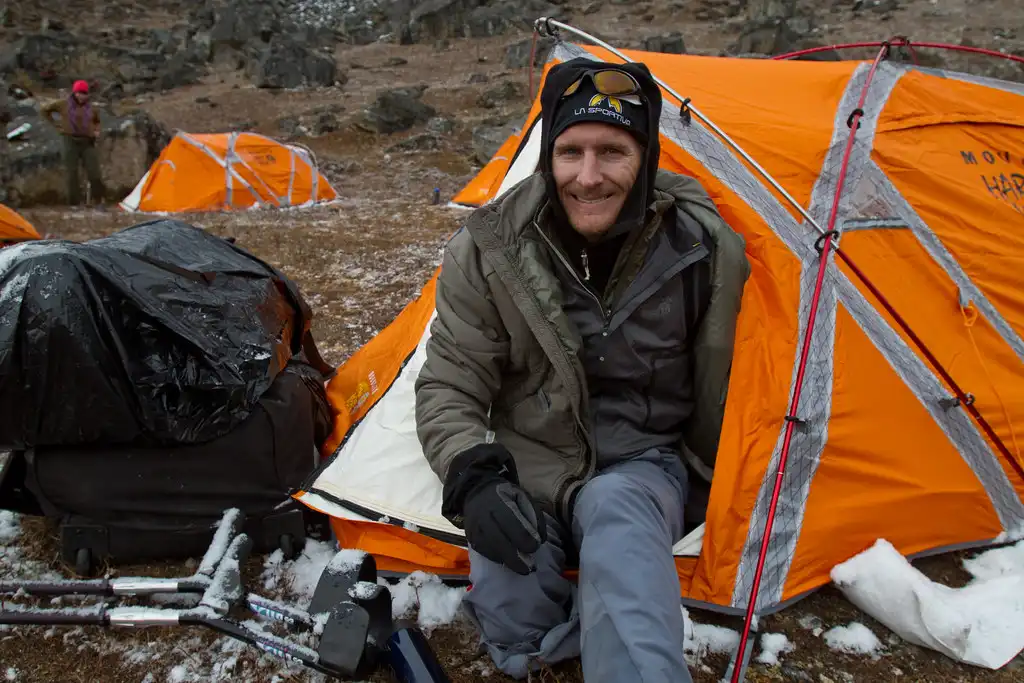
The South Ridge route is preferred due to its established path and relative safety compared to other routes. It involves a combination of rocky terraces, snowfields, and ice slopes. While the South Ridge is the standard, an alternative route exists via the East Face. However, the East Face is less popular because it presents more significant technical challenges and increases the overall Lobuche Peak Climbing Difficulty. Key points about the routes:
South Ridge Route:
- The climb starts from Lobuche Base Camp.
- The ascent continues to High Camp for acclimatization.
- The route involves a mix of rock, snow, and ice terrain.
- Preferred for its established path and safety.
East Face Route:
- Less frequent due to increased technical difficulty.
- Advanced technical climbing skills are required for the ascent.
- Greater exposure to objective hazards like avalanches.
Notable Sections
The Lobuche Peak climb includes several critical sections that contribute to its difficulty. Awareness of these helps climbers mentally and physically prepare for the challenges ahead.
Glacier Crossing
One of the first significant challenges is the glacier crossing after leaving High Camp. The glacier is riddled with crevasses, requiring careful navigation. Climbers must be adept at using crampons and should be roped together for safety. The icy terrain demands concentration and proper technique, adding to the overall Lobuche Peak Climbing Difficulty. Key considerations:
- The use of ropes and harnesses is essential.
- Awareness of hidden crevasses.
- Steady pace to conserve energy.
Ice Walls
Beyond the glacier, climbers face steep ice walls that can incline as much as 70 degrees. Ascending these walls requires the use of fixed ropes. Proficiency with ascenders (jumars) and climbing on steep ice is crucial. These sections are physically demanding and test a climber’s technical abilities, highlighting the technical climbing in Nepal required for Lobuche Peak. Important points:
- Guides set up fixed ropes.
- Proper technique with ice axes and crampons is necessary.
- Resting at anchor points can help manage fatigue.
Final Summit Ridge
The final ascent to the summit requires traversing a narrow and exposed ridge. This knife-edge ridge is one of the most challenging parts of the Lobuche Peak Climbing Difficulty. The drop-offs on either side are significant, and the path is only wide enough for one person at a time. The altitude and exposure make this section both mentally and physically taxing. Tips for the summit ridge:
- Maintain focus and balance.
- Move slowly and deliberately.
- Follow the guide’s instructions closely.

Required Skills and Experience
Technical Skills
To successfully navigate the Lobuche Peak Climbing Difficulty, climbers must possess strong technical skills. Proficiency in using essential climbing equipment is crucial. It includes:
- Crampons: Navigating icy and steep snow slopes requires confidence in using crampons effectively.
- Ice Axes: Mastery of ice axe techniques is vital for ascent and descent on icy terrains.
- Harnesses and Ropes: Enhancing safety during the climb involves understanding rope management, which includes tying knots and belaying.
- Fixed Ropes Usage: On steep sections, familiarity with ascenders (jumars) and the ability to ascend and descend fixed ropes are essential.
Previous Experience
Prior experience in high-altitude trekking or climbing is highly recommended, given the climbing difficulty. Climbers should have:
- High-Altitude Trekking Experience: Previous treks above 5,000 meters help acclimatize the body to thin air and reduce the risk of altitude sickness.
- Introductory Mountaineering Courses: Participation in courses that cover rock and ice climbing techniques provides a solid foundation.
- Climbing Smaller Peaks: Attempting less technical peaks like Island Peak or Mera Peak can serve as good preparation.
- Physical Fitness: A high cardiovascular endurance and strength level is necessary to handle the physical demands.
Altitude Challenges
Acclimatization
Proper acclimatization is crucial when considering the Lobuche Peak Climbing Difficulty. Ascending to high altitudes too quickly increases the risk of altitude sickness. To prevent this, climbers should follow a gradual ascent schedule.
Suggested acclimatization schedule:
- Day 1-2: Trek from Lukla to Namche Bazaar (3,440 meters). Rest for a day to adjust.
- Day 3-4: Hike to Tengboche (3,860 meters) and then to Dingboche (4,410 meters).
- Day 5: Acclimatization day at Dingboche. Short hikes to higher elevations and return to sleep low.
- Day 6-7: Proceed to Lobuche Village (4,940 meters) and rest.
- Day 8: Reach Lobuche Base Camp (4,950 meters). Prepare for the climb.
Health Risks
Altitude sickness is a serious concern. Symptoms include:
- Headaches
- Nausea and vomiting
- Dizziness
- Shortness of breath
- Fatigue
If symptoms worsen, immediate descent is necessary. Ignoring these signs can lead to severe conditions like High Altitude Pulmonary Edema (HAPE) or High Altitude Cerebral Edema (HACE). These are life-threatening and require urgent medical attention. Key points:
- Monitor Health: Regularly check oxygen saturation levels.
- Stay Hydrated: Drink enough water.
- Avoid Alcohol and Smoking: These can exacerbate symptoms.

Preparation and Training for Overcoming the Lobuche Peak Climbing Difficulty
Physical Fitness
Preparing for the Lobuche Peak climb demands a high level of physical fitness. A well-rounded training regimen should focus on:
- Cardiovascular Endurance: Running, cycling, and swimming improve heart and lung capacity.
- Strength Training: Build muscle strength with weightlifting exercises targeting the legs, core, and upper body.
- Flexibility: Incorporate yoga or stretching routines to enhance flexibility and reduce injury risk.
- Stamina Building: Long hikes with a weighted backpack simulate trekking conditions.
Technical Training
Technical skills are crucial due to the peak’s challenging terrain. To build confidence and competence:
- Rock Climbing Courses: Learn climbing techniques, harness usage, and rope management.
- Ice Climbing Workshops: Practice using ice axes and crampons on steep ice surfaces.
- Crevasse Rescue Training: Understand how to perform rescues in glacier environments.
Best Time to Climb
Choosing the right season is crucial for effectively managing the Lobuche Peak Climbing Difficulty. The weather conditions in Nepal greatly influence the safety and success of your climb.
Optimal Seasons
The best time to climb Lobuche Peak is during the pre-monsoon (March to May) and post-monsoon (September to November) seasons. These periods offer stable weather and clear skies, ideal for a Lobuche Peak expedition. During the pre-monsoon season, temperatures are moderate, and the climbing routes are less crowded. In the post-monsoon season, the air is crisp, and visibility is excellent, providing stunning views of the Himalayas. Key points:
Pre-Monsoon (March-May):
- Moderate temperatures
- Blooming rhododendrons enhance the trek
- Longer daylight hours
Post-Monsoon (September-November):
- Clear skies with minimal precipitation
- Cooler temperatures
- Festivals like Dashain and Tihar add cultural experiences
Weather Considerations
Weather significantly impacts the Lobuche Peak Climbing Difficulty. Adverse conditions like heavy snowfall, strong winds, and low temperatures can make climbing more challenging and dangerous. During the optimal seasons, the likelihood of such extreme weather is lower. Factors to consider:
- Wind Conditions: High winds can make the ascent risky, especially on exposed ridges.
- Temperature Fluctuations: Extreme cold at night requires proper gear to prevent hypothermia.
- Precipitation: Snow and rain can create slippery conditions, increasing the risk of falls.
- Visibility: Clear weather is essential for route finding and safety.

Permits and Regulations
Understanding the necessary permits and regulations is crucial for managing the Lobuche Peak Climbing Difficulty. Adhering to these requirements ensures a smooth expedition and promotes responsible climbing practices in Nepal.
Necessary Permits
Before starting your Lobuche Peak expedition, you must secure several permits:
1. Nepal Mountaineering Association (NMA) Permit: This is mandatory for climbing Lobuche East Peak. The cost varies depending on the season:
- Spring (March-May): USD 250 per person
- Autumn (September-November): USD 125 per person
- Winter and Summer: USD 70 per person
2. Sagarmatha National Park Entry Permit: This permit is required to enter the Everest region, where Lobuche Peak is located. The fee is NPR 3,000 (approximately USD 30) per person.
3. Khumbu Rural Municipality Permit: This permit was introduced to support local development. The fee is NPR 2,000 (approximately USD 20) per person.
Summary of Required Permits:
- Nepal Mountaineering Association (NMA) Permit
- Sagarmatha National Park Entry Permit
- Khumbu Rural Municipality Permit
Regulatory Compliance
Compliance with local regulations is a legal requirement and a responsibility towards sustainable mountaineering. By adhering to the rules set by authorities, climbers help preserve the natural environment and support local communities. Key points:
- Environmental Protection: To minimize impact, follow the “Leave No Trace” principles.
- Waste Management: Properly dispose of all waste to clean the trails and campsites.
- Respect Wildlife: Avoid disturbing local flora and fauna.
- Cultural Sensitivity: Honor local customs and traditions, especially when visiting monasteries and villages.
Equipment and Gear
Having the right equipment is vital to tackle the Lobuche Peak Climbing Difficulty. Proper gear enhances safety, comfort, and performance during the climb.
Essential Gear
Personal Clothing
- Base Layers: Moisture-wicking thermal tops and bottoms
- Insulating Layers: Fleece jackets and insulated pants
- Outer Shells: Waterproof and windproof jackets and trousers
- Down Jacket: For extreme cold at higher altitudes
- Gloves: Inner liners and insulated outer gloves
- Headwear: Warm hat, balaclava, and sun hat
- Footwear: High-altitude climbing boots and trekking shoes
- Socks: Thermal and liner socks
Technical Equipment
- Crampons: Compatible with your climbing boots
- Ice Axe: For ascent and descent on icy slopes
- Harness: Essential for roped sections
- Climbing Helmet: Protects against falling debris
- Carabiners: Locking and non-locking types
- Ascenders (Jumars): For fixed rope climbing
- Belay Device: For controlling rope during descent
- Prusik Loops: For safety backup
- Trekking Poles: Helpful during the approach
Other Essentials
- Backpack: 40-50 liters capacity for day use
- Sleeping Bag: Rated for -20°C or lower
- Headlamp: With extra batteries
- Sunglasses: UV protection for high-altitude glare
- Water Bottles and Thermos: Staying hydrated is crucial
- First Aid Kit: Personal medications and basic supplies
- Sun Protection: Use sunscreen and lip balm with a high SPF to protect your skin from the sun.
Rental Options
If bringing all your gear isn’t feasible, renting equipment is a viable option. Both Kathmandu and Namche Bazaar offer rental services.
In Kathmandu
- Wide Selection: Larger shops with extensive inventories
- Quality: Varied, so inspect equipment carefully
- Pricing: Competitive rates due to multiple vendors
In Namche Bazaar
- Convenience: Closer to the trekking route
- Limited Stock: Smaller selection compared to Kathmandu
- Last-Minute Needs: Good for forgotten items or replacements
Pros of Renting:
- Reduces luggage weight
- Cost-effective for one-time climbers
- Opportunity to use high-quality gear without purchasing
Cons of Renting:
- Fit and comfort may not be ideal
- Availability of specific sizes or models isn’t guaranteed
- Hygiene concerns with used personal items

Safety Considerations
Risk Management
Addressing the Lobuche Peak Climbing Difficulty requires meticulous attention to safety. Following established safety protocols is non-negotiable. Regular health check-ups during the trek help monitor acclimatization progress and detect early signs of altitude sickness. Climbers should be prepared for emergencies by having a clear action plan and necessary equipment. Key risk management strategies include:
- Adherence to Safety Protocols: Always follow the guidance of experienced guides and Sherpa leaders.
- Health Monitoring: Use pulse oximeters to check oxygen saturation and heart rate regularly.
- Emergency Preparedness: Carry a comprehensive kit and know basic wilderness first aid.
- Buddy System: Trek in pairs or groups to ensure mutual safety and assistance.
- Awareness of Surroundings: Stay vigilant about weather changes and terrain conditions.
Rescue Services
In severe altitude sickness or accidents, helicopter rescue services are available in the Everest region. However, these services are expensive and require proper insurance coverage. Important considerations:
- Insurance Coverage: Obtain travel insurance that includes high-altitude trekking and emergency evacuation up to 6,500 meters.
- Emergency Contacts: List emergency contacts, including your insurance provider and local rescue teams.
- Communication Devices: Carry reliable means of communication, such as satellite phones or radios.
- Understanding Limitations: Be aware that weather conditions can affect the availability and timing of rescue operations.
Cultural and Environmental Respect
Local Communities
Respectful interaction with the Sherpa communities enhances the climbing experience. The Sherpa people are integral to expeditions, offering invaluable support and cultural richness. Guidelines for positive engagement:
- Cultural Sensitivity: Learn basic Nepali phrases and understand local customs.
- Respect Religious Sites: Ask for permission before entering monasteries and refrain from touching sacred objects.
- Support Local Economy: Support local businesses by buying goods and services from them, helping to strengthen the community.
- Etiquette: Dress modestly and follow social norms to show respect.
Environmental Conservation
Preserving the natural beauty of the Himalayas is essential for sustainable tourism. Key environmental practices:
- “Leave No Trace” Principles: Pack all trash, including biodegradable waste.
- Stay on Designated Trails: Prevent erosion and protect fragile ecosystems by not veering off marked paths.
- Wildlife Respect: Observe animals from a distance without disturbing their natural behavior.
- Resource Conservation: Use water sparingly and avoid polluting streams and rivers.
Conclusion
Climbing Lobuche Peak demands significant physical endurance and technical skills. The “Lobuche Peak Climbing Difficulty” stems from steep ice slopes, knife-edge ridges, and the challenges of high-altitude environments. To overcome these obstacles, climbers must thoroughly prepare, including physical training and technical skill development. By understanding the risks and strictly adhering to safety protocols, climbers can enhance their chances of a successful summit.
Despite these challenges, the rewards of the Lobuche Peak climb are immense. Reaching the summit provides breathtaking panoramic views of the Himalayas and brings a profound sense of achievement. By respecting local cultures, preserving the environment, and preparing diligently, climbers can transform this demanding ascent into a memorable and fulfilling experience. With determination and careful planning, climbers can achieve the goal of conquering Lobuche Peak.
